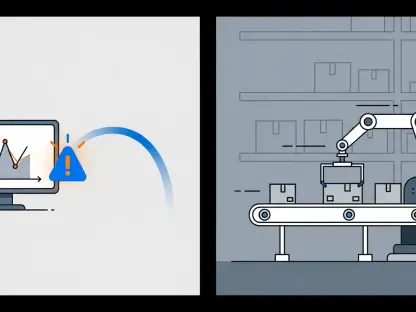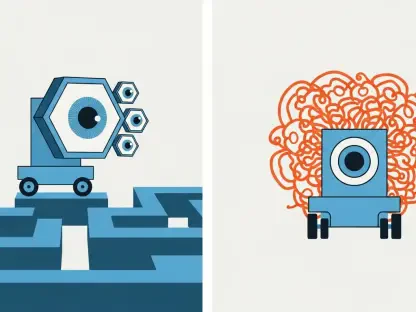The rapid evolution of AI technology presents users with a multitude of choices to enhance their digital interactions and professional workflows. As AI chatbots become more integral in various sectors, selecting the right model that best suits specific needs is paramount. OpenAI’s ChatGPT-4 and ChatGPT-3.5 offer distinct functionalities tailored to different user requirements. In this article, we explore the features and applications of these two chatbot models to help make an informed decision.
ChatGPT-4: Advanced Capabilities for Professional and Complex Tasks
Multimodal Processing and Contextual Understanding
ChatGPT-4 stands out with its impressive multimodal capabilities, allowing it to process both text and images. This feature significantly enhances its utility in diverse applications such as data analysis, customer service, and content creation. Professionals who require AI integration for detailed and context-rich interactions will find ChatGPT-4 particularly advantageous. With a larger context window, this model can manage more extensive conversations, providing accurate and coherent responses even in complex scenarios.
The advanced reasoning abilities of ChatGPT-4 allow it to excel in tasks that demand high levels of precision and insight. This model is designed to navigate through intricate questions and deliver well-thought-out answers, making it a valuable tool for researchers and businesses. Its ability to support internet browsing, available in specific plans, ensures that users can access real-time information directly through the chatbot, enhancing its effectiveness as a research assistant.
Subscription and Accessibility
While ChatGPT-4 offers notable enhancements over its predecessor, accessing these premium features comes at a cost. Subscriptions start at $20 per month, which may be a consideration for budget-conscious users. However, for those who prioritize advanced AI capabilities and the associated benefits, the investment in ChatGPT-4 can be justified. This fee-based structure ensures that users receive the most up-to-date functionalities and continuous improvements.
Moreover, the integration of ChatGPT-4 into various professional settings highlights its adaptability and scalability. From automating customer support to assisting in project management, the model’s capabilities extend beyond simple task execution, providing strategic insights and operational efficiency. Businesses leveraging this technology can expect enhanced productivity and streamlined operations, making it a prudent choice for those aiming to stay ahead in competitive markets.
ChatGPT-3.5: A Practical Solution for Everyday Use
General-Purpose Functionality and Accessibility
In contrast to the professional-grade capabilities of ChatGPT-4, ChatGPT-3.5 serves as an efficient, all-purpose chatbot that caters to everyday needs. This model’s strength lies in its user-friendliness and accessibility, offering essential AI functionalities without the associated subscription costs. Casual users and those with basic AI requirements will find ChatGPT-3.5 highly suitable for tasks like drafting emails, answering queries, or providing conversational support.
Despite lacking some of the advanced features found in ChatGPT-4, ChatGPT-3.5 remains a robust option for general use. Its ability to support voice interactions on mobile devices adds an extra layer of convenience, allowing users to interact with the model hands-free. Setting up ChatGPT-3.5 is straightforward with an OpenAI account, making it easily accessible to a broader audience without the complexities that typically accompany advanced AI systems.
Functionality and Cost-Free Benefits
The no-cost aspect of ChatGPT-3.5 is a significant draw for many users, particularly those who are exploring AI capabilities for the first time or require a simple, effective solution for routine tasks. Functionality-wise, it may not offer the exhaustive data handling and contextual depth of ChatGPT-4, but it compensates with ease of use and reliability in handling standard inquiries and tasks. This makes it ideal for students, freelancers, and individuals seeking to leverage AI for productivity and efficiency without financial outlay.
Furthermore, the model’s accessibility encourages more widespread AI adoption, allowing more people to experience the benefits of conversational AI. Educational institutions, smaller businesses, and personal users can greatly benefit from ChatGPT-3.5’s capabilities, promoting a more inclusive approach to technological advancement. Its simplicity in use combined with zero-cost access underscores its potential as a gateway for users stepping into the realm of AI-driven tools.
Exploring Alternative AI Models
Google’s Gemini and Anthropic’s Claude
For users who might not find OpenAI’s offerings suitable, alternative AI models present compelling options. Google Gemini, previously known as Bard, seamlessly integrates with Google Search, offering robust multimodal processing capabilities. This makes it an excellent choice for tasks that require synthesis and integration of diverse information sources. Moreover, the availability of a free tier ensures that users have access to essential features without immediate financial commitment, allowing for broader experimentation and adoption.
Anthropic’s Claude places a strong emphasis on ethical AI development and security, catering to users who prioritize these aspects in their AI usage. With one of the largest context windows available, Claude is particularly advantageous for long-form content creation and detailed informational tasks. This model’s commitment to ethical standards ensures users that safety and integrity are maintained in every interaction, providing peace of mind for privacy-conscious individuals and organizations.
Microsoft’s Copilot
Microsoft Copilot, designed to work seamlessly with Microsoft 365 applications, offers another viable alternative for productivity and development workflows. Its deep integration with familiar tools such as Word, Excel, and Outlook enhances user experience by embedding AI functionalities within everyday software. This integration supports a more intuitive approach to task management, potentially transforming workplace productivity and efficiency.
Additionally, Copilot’s compatibility with Bing enables enriched search capabilities, combining powerful AI-driven insights with online information retrieval. This dual functionality supports a comprehensive workflow management system, making Microsoft Copilot an attractive option for enterprises and individual users focused on optimizing their digital environments. By leveraging these alternatives, users can select AI models tailored to their specific requirements and usage contexts.
Making an Informed Decision
The swift progression of AI technology equips users with numerous options to improve their digital experiences and professional routines. As AI chatbots become essential across various industries, choosing the right model tailored to specific demands is crucial. OpenAI’s ChatGPT-4 and ChatGPT-3.5 each provide unique functionalities designed for different sets of requirements. In this article, we delve into the characteristics and uses of these two chatbot models to guide users in making a well-informed choice.
ChatGPT-3.5, for instance, is noted for its efficient performance in handling a broad spectrum of tasks, from customer service to content creation. Its adaptability and user-friendly nature make it an excellent option for those seeking dependable AI assistance. On the other hand, ChatGPT-4 brings enhanced capabilities, including better context understanding and more accurate responses, making it suitable for complex tasks that require a higher level of sophistication. By comparing these models, users can determine which AI solution aligns best with their specific goals and workflows, ensuring a more streamlined and productive digital experience.









